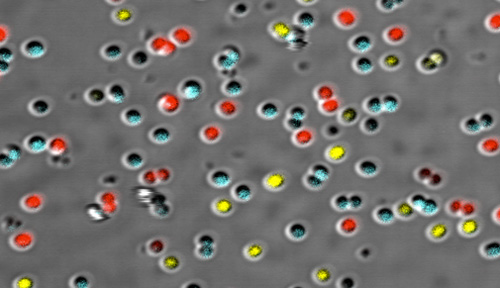Has been used by scientists from 85 laboratories and 12 countries
Through the creation of a library of more than 2,000 mutant strains of the Staphylococcus aureus bacteria, UNMC has provided an important tool for scientists around the world seeking answers for how to better deal with staph infections.
The project – detailed in the Feb. 12 issue of mBio, the journal of the American Society for Microbiology – was spearheaded by Paul Fey, Ph.D., first author, and Ken Bayles, Ph.D., senior author.
Dr. Fey is professor, pathology and microbiology, and medical director of clinical microbiology. Dr. Bayles is associate vice chancellor for basic science research and director of the UNMC Center for Staphylococcal Research.
Developed over the past four years, the library of mutant staph bacteria is essential in allowing scientists to better understand how staph genes cause infections. It also is critical in helping pharmaceutical companies develop new drugs to combat staph infections.
The mutant strains have been deposited in the Network on Antimicrobial Resistant Staphlococcus Aureus (NARSA), a repository funded by the National Institutes of Health. There is no cost for scientists to acquire these mutant strains.
NARSA has already provided nearly 2,600 mutant strains to scientists from 85 different laboratories and 12 countries. The entire library has been sent to 20 different labs around the world including labs in Germany, Switzerland, China, Ireland and England.
“Based on the high usage, it’s clearly making a difference to the scientific community,” Dr. Fey said. “This was a significant undertaking, so it’s rewarding to see that other investigators appreciate what we have done.”
Dr. Fey said it often takes several months for scientists to develop a single mutant strain. “Having access to the library of mutant strains saves them a lot of time and work, and it allows for rapid hypothesis generation for their research,” he said.
To complement the library of mutant strains, Jeffrey Bose, Ph.D., a fellow in pathology and microbiology, created a variety of genetic tools to help investigators better utilize the library. His work will be featured next month in Applied and Environmental Microbiology.
Dr. Fey also cited Robert Boissy, Ph.D., internal medicine administration, for providing his biomedical informatics expertise in the analysis of the genetic data. Three research techs – Jennifer Endres, Vijaya Kumar Yajjala and Todd Widhelm – also were involved on the project.
The project was funded by a $1.9 million earmark that former Nebraska Sen. Ben Nelson was able to procure from the U.S. Department of Defense in 2009.
With a team of six faculty, five post-doctoral fellows and 18 graduate students, UNMC has become one of the premier staph research programs in the country. The UNMC Center for Staphylococcal Research is the only one of its kind in the U.S.
“Staph is a big problem in our society and it’s only growing,” Dr. Bayles said. The emergence of drug-resistant staph bacteria, such as community-acquired methicillin-resistant Staphylococcus aureus (CA-MRSA), has been found in schools and other common community settings.
“It used to be that staph was primarily confined to surgical situations,” Dr. Bayles said, “but now it has moved into the mainstream and is affecting perfectly healthy people.”
More than 19,000 people in the United States die from staph infections each year. That’s 3,000 more people than who die from HIV/AIDS.
It is estimated that 30 percent of people are long-term carriers of staph bacteria, which can be found in the thousands of microorganisms that reside on the skin and in the nasal passages.
Staph infections are the most common hospital-associated infection. Staph bacteria can bind to metal or plastic, so they are commonly associated with joint replacements or catheters.
